Bulletin #2243, Maintaining a Home Lawn in Maine
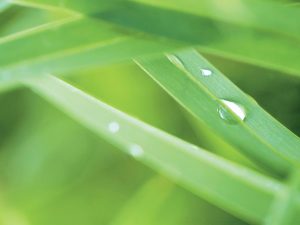
Prepared by Lois Berg Stack, Extension Ornamental Horticulture Specialist, the University of Maine Cooperative Extension
Reviewed and updated by Manjot Kaur Sidhu, Assistant Extension Professor of Horticulture and Ornamental Horticulture Specialist, University of Maine Cooperative Extension
For information about UMaine Extension programs and resources, visit extension.umaine.edu.
Find more of our publications and books at extension.umaine.edu/publications/.
Lawns are important parts of most home landscapes because they provide an area for recreation and instill a sense of space in the landscape. Small areas of most home lawns present a variety of challenges: low spots accumulate water in spring and after heavy rainfalls; south-facing slopes dry out excessively in summer, and edges can be invaded by weeds from adjacent beds and borders. In addition to these challenges, lawns are living plants that require nutrients, water and some maintenance such as mowing.
Common maintenance tasks for home lawns include:
Mowing
Mowing helps maintain a clean, finished appearance. Proper mowing also reduces weed and disease problems and encourages turf grass vigor.
Mowing height: Mowing height depends on:
Turf grass type: Bunch-type grasses, such as tall fescue and perennial ryegrass, must be mowed to a height of 3″ or more because their growing points are above ground. Sod-forming grasses such as fine fescues and Kentucky bluegrass can be mowed lower because they grow from a point at or slightly below ground level. Lawns that contain both bunch-type and sod-forming grasses should be mowed high to accommodate the bunch grasses.
Environmental conditions: Higher mowing during hot weather protects and insulates the growing points of cool-season turf grasses. Higher mowing results in more leaf area, more photosynthesis, and deeper root systems. This enables the grasses to withstand periodic high-temperature stress. If the growing points of turf grass plants are damaged, a stubby, brown appearance results. Lawns grow in response to environmental conditions; lawns require more frequent mowing in the cool, moist weather of spring and fall when they grow rapidly than in the hot, dry conditions of midsummer when they grow more slowly or even go dormant.
Stage of growth: Mow a newly seeded lawn when it reaches a height of four inches. Early mowing promotes the spreading and thickening of the grass. Do not allow the new grass to become excessively long before the first mowing.
Desired maintenance level: Some grasses, such as the “low-maintenance” mixes composed primarily of turf-type tall fescues, can be mowed as few as two or three times each year, thereby producing a taller meadow-like appearance. If you are managing a lawn in this way, take extra care to ensure that your mower’s blade is very sharp, to avoid tearing the rather tough, mature grass blades. Some people are willing to manage lawns at a much higher maintenance level, to achieve a carpet-like effect. Such lawns require not only frequent mowing but also more frequent irrigation because low mowing reduces root depth and plant vigor. Also, low mowing reduces the grass’s ability to out-compete weeds, thereby increasing the need to hand-weed or apply herbicides. In general, most home lawns should be mowed at the high end of the height range recommended in Table 1.
Mowing frequency: Determine mowing frequency according to grass growth rate rather than the calendar. Follow the “one-third rule”: remove no more than one-third of the total leaf height at one mowing. For example, if you want to mow Kentucky bluegrass lawn to three inches, mow when the grass reaches four to 4½ inches in height. Removing more than one-third of the height causes stress, depletes stored carbohydrates, and may result in thinning.
Clipping removal: Lawn clippings contain nutrients and carbon that should be returned to the lawn wherever possible. These clippings decompose over time, thereby supplying the grass plants with nutrients such as nitrogen and adding organic matter to the soil to increase its ability to hold nutrients and water. Clippings generally don’t contribute to thatch buildup, because they break down quickly.
Where possible, use a mulching mower. Mulching mowers are rotary mowers with double blades that cut the clippings into very small pieces that sift down to the soil and decompose quickly. If you use a mulching mower, you can reduce your yearly fertilizer application rate by 1/3 to 1/2.
In some situations, clippings should be removed from the site. Remove clippings from a weedy lawn, to prevent weed seeds from growing and taking over your lawn. If mowing a very tall lawn, rake off the clippings because if left in place, they shade the lawn and create a moist environment that favors disease development.
Grass clippings that are removed from a lawn can be composted unless they contain an herbicide from a recent application of a weed-killing chemical.
Mower selection and operation: When selecting and operating a lawn mower, consider both your lawn and your personal needs. Match your mower capacity to the size of your lawn so that mowing can be done in a reasonable amount of time. A riding lawn mower is most appropriate for a large, flat lawn with few obstacles, while a walk-behind mower is a better choice for a small lawn with many trees, sharp turns or small planting beds.
Two basic types of lawn mowers are available: reel and rotary. Reel mowers have a cylinder of blades that provide a clean, flat cut, but generally, are more expensive and hard to sharpen. They yield the most manicured effect. They do not easily cut tall grass, so are well suited to situations where frequent mowing is possible. Manual single-reel mowers are an excellent choice for small lawns.
Rotary mowers have a horizontal blade; mulching rotary mowers have a double horizontal blade. Rotary mowers cost less that reel mowers can be used to cut tall grass, and are easily sharpened and maintained. However, they often shred grass blades, producing a rougher cut.
Whichever mower you choose, read the operator’s manual and maintain the mower appropriately. Sharpen blades frequently, as dull blades tear grass rather than cut it, leaving a brownish color on the cut surface of the lawn.
Follow these lawnmower safety tips:
- Remove fallen branches and other objects from the lawn before mowing.
- Wear sturdy shoes and long pants when mowing.
- Wear leather gloves to protect hands and reduce hand fatigue.
- Keep other people and animals at a safe distance.
- Keep feet and hands away from all blades when in operation.
- Operate mowers at low travel speeds.
- Always push a walk-behind mower; do not pull it toward yourself.
- Watch your footing on wet areas and slopes.
- Do not leave the engine running unattended.
- Refuel only when the mower is shut off and cool.
- Stop the engine and disconnect spark plugs before doing maintenance.
Fertilizing
All plants need nutrients, which can be applied as composted or processed organic matter or as synthetic fertilizer. It is important to apply the appropriate type and amount of fertilizer at the correct time, in order to prevent excess nutrients from leaching down to groundwater or running off to surface waters.
If your lawn is healthy and you are satisfied with its performance, there may be no need to add fertilizer. If you use a mulching mower, you are already fertilizing by leaving the grass clippings in place to break down and provide nutrients to your lawn.
If your lawn does not look healthy, first determine the cause of the problem. Fertilizer provides nutrients that a healthy lawn can absorb to produce new growth, but fertilizer does not aerate compacted soil or kill damaging insects or cure lawn diseases or solve other problems.
If you believe that fertilizer is needed, have your soil tested to find out which nutrients and how much of each is lacking. Adding unneeded nutrients is a waste of time and resources, and can harm the environment.
If fertilizer is needed, follow these guidelines:
- Fertilize established lawns with a phosphorus-free fertilizer (look for “0” as the middle number in a fertilizer bag’s analysis; e.g., 15-0-10). Phosphorus fertilizer is, however, required in some new lawn seedings.
- Because lawns are fertilized not more than twice each year, it is important to apply a fertilizer that will release slowly over time. Check fertilizer labels, and purchase a product in which at least some of the nitrogen is labeled “slow-release, “slowly available” or “water insoluble.” These products provide nitrogen for a longer period and reduce the likelihood of some nitrogen running off into surface water.
- Do not use a product that contains fertilizer plus weed killer. The application rates of these products are based on the weed killer, not the fertilizer.
- Do not apply more than two pounds of nitrogen per 1000 square feet of lawn per year.
- If adding fertilizer once a year (one pound or less of nitrogen per 1000 square feet), apply it between August 15 and September 15. If more than this amount is recommended by your soil test results, apply the remainder in May, after spring green-up.
- If you mow with a mulching mower, reduce the recommended annual rate by 1/3 – 1/2.
- Leave a strip of at least 25 feet of lawn or other plantings unfertilized next to water bodies.
- Do not apply fertilizer if a moderate-to-heavy rain is imminent.
Refer to Bulletin #2154, Fertilizing a Home Lawn in Maine for details about when and how to fertilize your lawn. Contact the Analytical Lab and Maine Soil Testing Service for soil testing information.
Managing Weeds
Moderate populations of weeds are acceptable in most home lawns. Many weeds support insects that pollinate some of our crops and provide food for birds and other animals. Some weeds add color and fragrance to the landscape. Many weeds survive even low mowing, and compete in parts of home lawns that do not support good grass growth.
However, weeds may be objectionable in some lawns. For example, some people consider white clover to be a positive component of lawns because clover fixes nitrogen and clover flowers provide forage for bees and other pollinators. Other people who are highly allergic to bee stings might want to prevent white clover growth.
Develop an integrated program of weed prevention, mechanical weed management, and chemical weed management.
Weed prevention is the best strategy because some lawn weeds are very difficult to control after they are established. Inspect soil, mulch, compost, grass seed or sod, and any other materials you plan to apply to your lawn. Follow good practices in preparing your site and establishing a lawn. Choose the best grass seed or seed mix for your conditions. Water and mow to promote competitive grass growth; low mowing and light or too-frequent irrigation lead to weed infestations. In addition, the build-up of thatch, compaction of soil and pest damage also give weeds a competitive edge. Avoid compaction from heavy traffic. Fertilize at appropriate rates and times.
In an established lawn, inspect your lawn periodically to make good weed management decisions. Establish your tolerance for weeds. Then, scout to determine which weeds are present, and in what number. Make a note of new weeds, and monitor them over time. If their numbers grow, identify them and determine if they require management. If you determine that weeds should be managed, select the method that best matches your philosophy and the level of management you desire.
Some weeds are indicators of specific problems. For example, white clover often invades a home lawn when conditions of low fertility and drought prevail. Broadleaved plantain is common in lawns that are heavily fertilized. Ground ivy usually invades a full-sun lawn from its shaded edges. Knotweed and spotted spurge grow in dry, compacted lawn areas next to walkways. Purslane sometimes invades dry, sandy areas of lawn. Wild strawberry is tolerant of acid soils and drought. Identifying weeds can help you diagnose underlying problems; controlling these problems can help overcome existing weeds and reduce future weed infestations.
Mechanical weed management methods include hand pulling, digging and cutting off flowers before they go to seed. These methods are effective on small populations of weeds. Scouting allows you to identify weeds while their numbers are still small enough to manage mechanically. Larger infestations of spreading weeds like quackgrass are more difficult to manage mechanically, but repeated digging can eventually deplete food reserves in the weeds’ root systems.
Chemical weed management may be deemed necessary in occasional situations. Contact your UMaine Extension County Office to discuss options. Poor timing, improper rates and use of the wrong product for specific weeds all lead to failure. When weed control products work, they provide an immediate solution to lawn weed problems, but that is only the first step. Long-term weed control requires an assessment of the situation, and a change in lawn grass choice, irrigation, mowing or other factor(s) that caused the weed problem to require management.
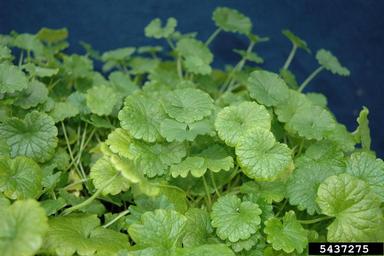
Ground ivy. Photo: Bruce Ackley, The Ohio State University, Bugwood.org 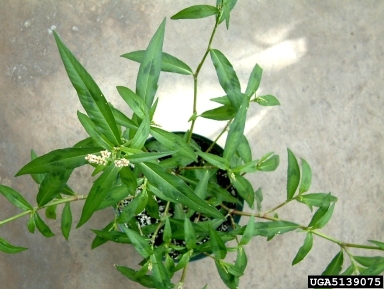
Knotweed. Photo: LynnSosnoski, University of Georgia, Bugwood.org 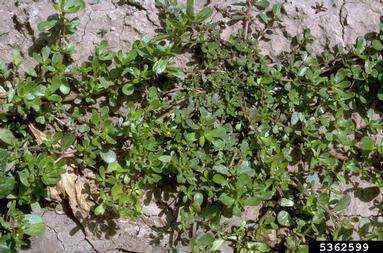
Common purslane. Photo: Howard F. Schwartz. Colorado State University, Bugwood.org 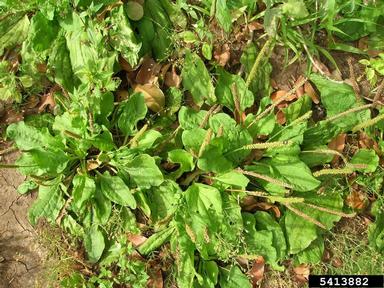
Broadleaf plantain. Photo: Forest and Kim Starr, Starr Environmental, Bugwood.org 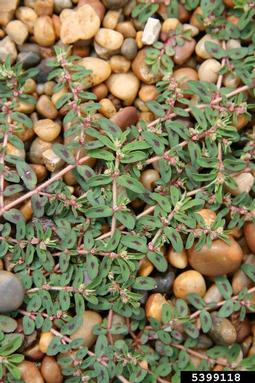
Spotted spurge. Photo: Robert Vidéki, Doronicum Kft., Bugwood.org
Managing Moss in the Home Lawn
Lawns out-compete mosses under conditions that favor healthy grass growth. In a home lawn, mosses generally grow where these problems exist: dense shade, low soil fertility, poor drainage, wet soil, compacted soil, and/or poor air circulation.
Although moss-killing chemicals are available, they are at best a temporary solution. When poor conditions are corrected and grasses are reestablished, the chemicals are not needed. Unless the conditions that favor mosses are corrected, the mosses will reestablish if they are manually or chemically removed. If the conditions cannot be corrected, consider an alternative to a lawn in those places. For example, you might mulch along the north side of a building where dense shade is unavoidable, or plant moisture-tolerant groundcovers in areas of wet soil.
Managing Insects and Diseases
Maine provides a near-perfect climate for cool season lawn grasses. When home lawns are well maintained, few insect or disease problems become serious.

Chinch bug damage usually appears as dead patches of lawn in midsummer, usually in dry years and often on south-facing slopes. When chinch bug numbers are high enough to cause obvious damage, you may see the 1/5-inch-long, black-and-white, winged adults moving around at the soil surface. For more information about identifying and managing this insect, refer to the Chinch Bugs, Pest Management Fact Sheet #5009.
White grubs have become more common inhabitants of Maine lawns in recent years. These ground-dwelling larvae of Japanese beetles, June beetles, Asiatic garden beetles, and European chafers feed on grass roots. Watch for patches of dead lawn that appear in spring or late summer, when root-feeding is at its peak. You may also see higher-than-normal numbers of skunks, crows or moles, but they may be present to feed on other soil-dwelling animals such as earthworms. To scout for grubs, cut and peel back a section of the grass to expose them. They are soft and white with a brown head, and they usually lie curled up in a “C”, just at the base of the grassroots. Refer to UMaine Extension Pest Management Office resources for more information about scouting, identifying, and managing white grubs. If your lawn has been heavily damaged by white grubs and you need to renovate your lawn, refer to Bulletin #2367, Establishing a Home Lawn in Maine for guidelines.
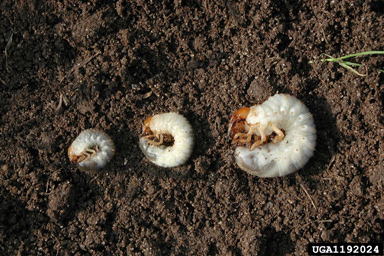
David Cappaert, Bugwood.org
Grass diseases are rarely serious on home lawns in Maine. The most common lawn disease on well-managed home lawns is snow mold. Both pink snow mold and gray snow mold appear as the snow melts in spring, generally after a winter of prolonged snow cover. The symptomatic roundish patches of dead and matted grass are a foot across or less. Patches of gray snow mold, which is more common in Maine than pink snow mold, disappear as the grass dries. Pink snow mold can invade grassroots but is very uncommon in Maine. These problems can be largely avoided by mowing late into the fall and applying fall fertilizer before September 15.
Information in this publication is provided purely for educational purposes. No responsibility is assumed for any problems associated with the use of products or services mentioned. No endorsement of products or companies is intended, nor is criticism of unnamed products or companies implied.
© 2011, 2025
Call 800.287.0274 (in Maine), or 207.581.3188, for information on publications and program offerings from University of Maine Cooperative Extension, or visit extension.umaine.edu.
In complying with the letter and spirit of applicable laws and pursuing its own goals of diversity, the University of Maine System does not discriminate on the grounds of race, color, religion, sex, sexual orientation, transgender status, gender, gender identity or expression, ethnicity, national origin, citizenship status, familial status, ancestry, age, disability physical or mental, genetic information, or veterans or military status in employment, education, and all other programs and activities. The University provides reasonable accommodations to qualified individuals with disabilities upon request. The following person has been designated to handle inquiries regarding non-discrimination policies: Director of Equal Opportunity and Title IX Services, 5713 Chadbourne Hall, Room 412, University of Maine, Orono, ME 04469-5713, 207.581.1226, TTY 711 (Maine Relay System).

